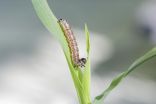(Press-News.org) (Edmonton, AB) Every year in Canada about 50,000 people suffer from a stroke, caused either by the interruption of blood flow or uncontrolled bleeding in the brain. While many environmental risk factors exist, including high blood pressure and smoking, stroke risk is also frequently inherited. Unfortunately, remarkably little is known regarding stroke's genetic basis.
A study from the University of Alberta, published in the Journal of Clinical Investigation, extends knowledge of stroke's genetic underpinnings and demonstrates that in some cases it originates in infancy.
The research identifies two genes (FOXC1 and PITX2) that cause cerebral small vessel disease, a "pre-stroke" condition that increases the risk of future stroke up to ten times. It was found the mutations result in cerebral small vessel disease in patients as young as one year of age. By inhibiting these genes in lab models, the researchers induced comparable brain vascular changes and gained key insights into the mechanisms involved.
The two genes are known to cause a type of pediatric glaucoma by affecting the normal migration of vital stem cells to the eye. These same stem cells also play a pivotal role in the formation of brain blood vessels, forming the smooth muscle in artery walls that is essential for structural integrity. A reduction in the number of these cells impairs vascular stability, and leads to cerebral small vessel disease. This in turn substantially increases the long term risk of stroke.
By demonstrating for the first time that a proportion of stroke has a developmental basis, the research has identified a very wide timeframe (five decades or more) between the onset of cerebral small vessel disease and a stroke occurring. This discovery provides ample opportunity for therapeutic intervention—currently with improved blood pressure control, statins, etc.—and the expectation that the findings will stimulate research to develop treatments targeting potential solutions.
Equally, the findings may provide novel insights in eye disease where the research originated. Some patients with pediatric glaucoma caused by the genes FOXC1 and PITX2 suffer gradual visual deterioration despite excellent surgical control of intraocular pressure. It has always been assumed that ongoing damage to the eye was responsible. However, the identification of extensive brain vascular changes provides an alternative explanation, and is expected to influence clinical management for these patients.
INFORMATION:
The research involved 11 collaborating Canadian, American and European laboratories, with funding provided by the Canadian Institutes of Health Research (CIHR), Heart and Stroke Foundation, Natural Sciences and Engineering Research Council (NSERC) and the National Institutes of Health (NIH). It was led by Ordan Lehmann, professor in the departments of ophthalmology and medical genetics at the University of Alberta].
To arrange an interview with Ordan Lehmann, please contact:
Ross Neitz, communications associate
Faculty of Medicine & Dentistry
780-492-5986 (office) rneitz@ualberta.ca
Genes causing pediatric glaucoma contribute to future stroke
2014-09-25
ELSE PRESS RELEASES FROM THIS DATE:
Unlocking long-hidden mechanisms of plant cell division
2014-09-25
AMHERST, Mass. – Along with copying and splitting DNA during division, cells must have a way to break safely into two viable daughter cells, a process called cytokinesis. But the molecular basis of how plant cells accomplish this without mistakes has been unclear for many years.
In a new paper by cell biologist Magdalena Bezanilla of the University of Massachusetts Amherst, she and her doctoral student Shu-Zon Wu present a detailed new model that for the first time proposes how plant cells precisely position a "dynamic and complex" structure called a phragmoplast at the ...
Risk of esophageal cancer decreases with height
2014-09-25
Bethesda, MD (Sept. 25, 2014) — Taller individuals are less likely to develop esophageal cancer and it's precursor, Barrett's esophagus, according to a new study1 in Clinical Gastroenterology and Hepatology, the official clinical practice journal of the American Gastroenterological Association.
"Individuals in the lowest quartile of height (under 5'7" for men and 5'2" for women) were roughly twice as likely as individuals in the highest quartile of height (taller than 6' for men and 5'5" for women) to have Barrett's esophagus or esophageal cancer," said Aaron P. Thrift, ...
Putting the squeeze on quantum information
2014-09-25
CIFAR researchers have shown that information stored in quantum bits can be exponentially compressed without losing information. The achievement is an important proof of principle, and could be useful for efficient quantum communications and information storage.
Compression is vital for modern digital communication. It helps movies to stream quickly over the Internet, music to fit into digital players, and millions of telephone calls to bounce off of satellites and through fibre optic cables.
But it has not been clear if information stored in quantum bits, or qubits, ...
Looking for a spouse or a companion
2014-09-25
New Rochelle, NY, September 25, 2014—The increasing popularity of social media, online dating sites, and mobile applications for meeting people and initiating relationships has made online dating an effective means of finding a future spouse. The intriguing results of a new study that extends this comparison of online/offline meeting venues to include non-marital relationships, and explores whether break-up rates for both marital and non-marital relationships differ depending on whether a couple first met online or offline are reported in an article in Cyberpsychology, ...
World's smallest reference material is big plus for nanotechnology
2014-09-25
If it's true that good things come in small packages, then the National Institute of Standards and Technology (NIST) can now make anyone working with nanoparticles very happy. NIST recently issued Reference Material (RM) 8027, the smallest known reference material ever created for validating measurements of these man-made, ultrafine particles between 1 and 100 nanometers (billionths of a meter) in size.
RM 8027 consists of five hermetically sealed ampoules containing one milliliter of silicon nanoparticles—all certified to be close to 2 nanometers in diameter—suspended ...
A galaxy of deception
2014-09-25
Astronomers usually have to peer very far into the distance to see back in time, and view the Universe as it was when it was young. This new NASA/ESA Hubble Space Telescope image of galaxy DDO 68, otherwise known as UGC 5340, was thought to offer an exception. This ragged collection of stars and gas clouds looks at first glance like a recently-formed galaxy in our own cosmic neighbourhood. But, is it really as young as it looks?
Astronomers have studied galactic evolution for decades, gradually improving our knowledge of how galaxies have changed over cosmic history. ...
The ideal age of sexual partners is different for men and women
2014-09-25
New evolutionary psychology research shows gender differences in age preferences regarding sexual partners.
Men and women have different preferences regarding the age of their sexual partners and women's preferences are better realized than are men's. Regarding the age of their actual sexual partners, the difference is however much smaller. Researchers in psychology at Åbo Akademi University in Turku, Finland, suggest that this pattern reflect the fact that when it comes to mating, women control the market.
Grounding their interpretation in evolutionary theory, the ...
Playing tag with sugars in the cornfield
2014-09-25
This news release is available in German. Sugars are usually known as energy storage units in plants and the insects that feed on them. But, sugars may also be part of a deadly game of tag between plant and insect according to scientists at the Max Planck Institute for Chemical Ecology. Grasses and crops such as maize attach sugars to chemical defenses called benzoxazinoids to protect themselves from being poisoned by their own protective agents. Then, when an insect starts feeding, a plant enzyme removes the sugar to deploy the active toxin. The Max Planck scientists ...
Brazilian zoologists discovered the first obligate cave-dwelling flatworm in South America
2014-09-25
Typical cave-dwelling organisms, unpigmented and eyeless, were discovered in a karst area located in northeastern Brazil. The organisms were assigned to a new genus and species of freshwater flatworm and may constitute an oceanic relict. They represent the first obligate cave-dwelling flatworm in South America. The study was published in the open access journal ZooKeys.
Freshwater flatworms occur on a wide range of habitats, namely streams, lagoons, ponds, among others. Some species also occur in subterranean freshwater environments.
Brazil has more than 11,000 caves, ...
Water research tackles growing grassland threat: Trees
2014-09-25
MANHATTAN — Two Kansas State University biologists are studying streams to prevent tallgrass prairies from turning into shrublands and forests.
By looking at 25 years of data on the Konza Prairie Biological Station, Allison Veach, doctoral student in biology, Muncie, Indiana, and Walter Dodds, university distinguished professor of biology, are researching grassland streams and the expansion of nearby woody vegetation, such as trees and shrubs. They have found that burn intervals may predict the rate of woody vegetation expansion along streams.
Their latest research ...






